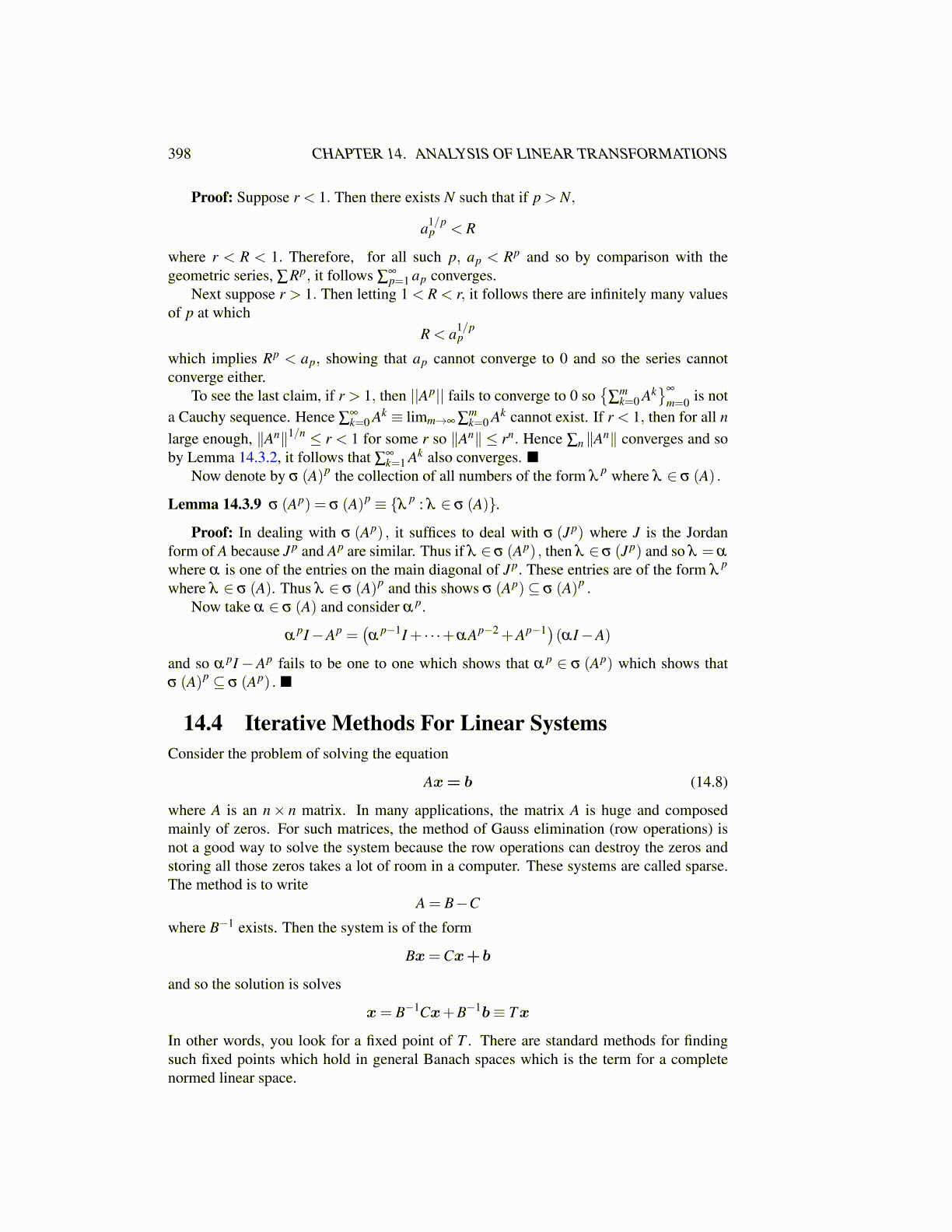
398 CHAPTER 14. ANALYSIS OF LINEAR TRANSFORMATIONS
Proof: Suppose r < 1. Then there exists N such that if p > N,
a1/pp < R
where r < R < 1. Therefore, for all such p, ap < Rp and so by comparison with thegeometric series, ∑Rp, it follows ∑
∞p=1 ap converges.
Next suppose r > 1. Then letting 1 < R < r, it follows there are infinitely many valuesof p at which
R < a1/pp
which implies Rp < ap, showing that ap cannot converge to 0 and so the series cannotconverge either.
To see the last claim, if r > 1, then ||Ap|| fails to converge to 0 so{
∑mk=0 Ak
}∞
m=0 is nota Cauchy sequence. Hence ∑
∞k=0 Ak ≡ limm→∞ ∑
mk=0 Ak cannot exist. If r < 1, then for all n
large enough, ∥An∥1/n ≤ r < 1 for some r so ∥An∥ ≤ rn. Hence ∑n ∥An∥ converges and soby Lemma 14.3.2, it follows that ∑
∞k=1 Ak also converges. ■
Now denote by σ (A)p the collection of all numbers of the form λp where λ ∈ σ (A) .
Lemma 14.3.9 σ (Ap) = σ (A)p ≡ {λ p : λ ∈ σ (A)}.
Proof: In dealing with σ (Ap) , it suffices to deal with σ (Jp) where J is the Jordanform of A because Jp and Ap are similar. Thus if λ ∈ σ (Ap) , then λ ∈ σ (Jp) and so λ = α
where α is one of the entries on the main diagonal of Jp. These entries are of the form λp
where λ ∈ σ (A). Thus λ ∈ σ (A)p and this shows σ (Ap)⊆ σ (A)p .Now take α ∈ σ (A) and consider α p.
αpI−Ap =
(α
p−1I + · · ·+αAp−2 +Ap−1)(αI−A)
and so α pI−Ap fails to be one to one which shows that α p ∈ σ (Ap) which shows thatσ (A)p ⊆ σ (Ap) . ■
14.4 Iterative Methods For Linear SystemsConsider the problem of solving the equation
Ax= b (14.8)
where A is an n× n matrix. In many applications, the matrix A is huge and composedmainly of zeros. For such matrices, the method of Gauss elimination (row operations) isnot a good way to solve the system because the row operations can destroy the zeros andstoring all those zeros takes a lot of room in a computer. These systems are called sparse.The method is to write
A = B−C
where B−1 exists. Then the system is of the form
Bx=Cx+b
and so the solution is solves
x= B−1Cx+B−1b≡ Tx
In other words, you look for a fixed point of T . There are standard methods for findingsuch fixed points which hold in general Banach spaces which is the term for a completenormed linear space.